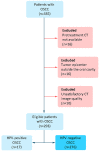Demographic and imaging features of oral squamous cell cancer in Serbia: a retrospective cross-sectional study
- PMID: 38287310
- PMCID: PMC10823646
- DOI: 10.1186/s12903-024-03869-8
Demographic and imaging features of oral squamous cell cancer in Serbia: a retrospective cross-sectional study
Abstract
Background: The mortality of oral squamous cell cancer (OSCC) in Serbia increased in the last decade. Recent studies on the Serbian population focused mainly on the epidemiological aspect of OSCC. This study aimed to investigate the demographic and imaging features of OSCC in the Serbian population at the time of diagnosis.
Methods: We retrospectively analyzed computed tomography (CT) images of 276 patients with OSCC diagnosed between 2017 and 2022. Age, gender, tumor site, tumor volume (CT-TV, in cm3), depth of invasion (CT-DOI, in mm), and bone invasion (CT-BI, in %) were evaluated. TNM status and tumor stage were also analyzed. All parameters were analyzed with appropriate statistical tests.
Results: The mean age was 62.32 ± 11.39 and 63.25 ± 11.71 for males and females, respectively. Male to female ratio was 1.63:1. The tongue (36.2%), mouth floor (21.0%), and alveolar ridge (19.9%) were the most frequent sites of OSCC. There was a significant gender-related difference in OSCC distribution between oral cavity subsites (Z=-4.225; p < 0.001). Mean values of CT-TV in males (13.8 ± 21.5) and females (5.4 ± 6.8) were significantly different (t = 4.620; p < 0.001). CT-DOI also differed significantly (t = 4.621; p < 0.001) between males (14.4 ± 7.4) and females (10.7 ± 4.4). CT-BI was detected in 30.1%, the most common in the alveolar ridge OSCC. T2 tumor status (31.4%) and stage IVA (28.3%) were the most dominant at the time of diagnosis. Metastatic lymph nodes were detected in 41.1%.
Conclusion: Our findings revealed significant gender-related differences in OSCC imaging features. The predominance of moderate and advanced tumor stages indicates a long time interval to the OSCC diagnosis.
Keywords: Demography; Oral cavity; Retrospective studies; Squamous cell Cancer; X-Ray computed Tomography.
© 2024. The Author(s).
Conflict of interest statement
The authors declare no competing interests.
Figures




Similar articles
-
Bioinformatics identification and validation of m6A/m1A/m5C/m7G/ac4 C-modified genes in oral squamous cell carcinoma.BMC Cancer. 2025 Jul 1;25(1):1055. doi: 10.1186/s12885-025-14216-7. BMC Cancer. 2025. PMID: 40597017 Free PMC article.
-
Prediction of nodal disease in oral squamous cell carcinoma of the tongue: histopathological risk assessment with the focus on depth of invasion.Clin Oral Investig. 2024 Aug 6;28(9):466. doi: 10.1007/s00784-024-05863-4. Clin Oral Investig. 2024. PMID: 39105864 Free PMC article.
-
Diagnostic accuracy of contrast-enhanced computed tomography in assessing cervical lymph node status in patients with oral squamous cell carcinoma.J Cancer Res Clin Oncol. 2023 Dec;149(19):17437-17450. doi: 10.1007/s00432-023-05470-y. Epub 2023 Oct 25. J Cancer Res Clin Oncol. 2023. PMID: 37875746 Free PMC article.
-
Preoperative evaluation of depth of invasion in oral tongue squamous cell carcinoma: A systematic review and meta-analysis.Oral Oncol. 2023 Jan;136:106273. doi: 10.1016/j.oraloncology.2022.106273. Epub 2022 Dec 13. Oral Oncol. 2023. PMID: 36521381
-
Systemic pharmacological treatments for chronic plaque psoriasis: a network meta-analysis.Cochrane Database Syst Rev. 2021 Apr 19;4(4):CD011535. doi: 10.1002/14651858.CD011535.pub4. Cochrane Database Syst Rev. 2021. Update in: Cochrane Database Syst Rev. 2022 May 23;5:CD011535. doi: 10.1002/14651858.CD011535.pub5. PMID: 33871055 Free PMC article. Updated.
Cited by
-
Clinical Relevance of FOXP3, PD-L1, PD-1, and miR-155 Gene Expression and Genetic Variants in HPV-Negative Oral Carcinomas.Int J Mol Sci. 2025 Jul 25;26(15):7218. doi: 10.3390/ijms26157218. Int J Mol Sci. 2025. PMID: 40806346 Free PMC article.
References
-
- Diz P, Meleti M, Diniz-Freitas M, Vescovi P, Warnakulasuriya S, Johnson NW et al. Oral and pharyngeal cancer in Europe: incidence, mortality and trends as presented to the global oral Cancer Forum. Transl Res Oral Oncol. 2017;2.
-
- Abed H, Reilly D, Burke M, Daly B. Patients with head and neck cancers’ oral health knowledge, oral health-related quality of life, oral health status, and adherence to advice on discharge to primary dental care: a prospective observational study. Spec Care Dentist. 2019;39:593–602. doi: 10.1111/scd.12418. - DOI - PubMed
MeSH terms
LinkOut - more resources
Full Text Sources
Medical

